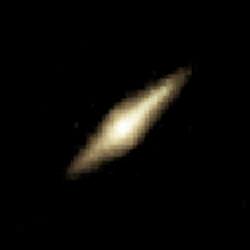Here’s the traditional thinking. The grand spiral galaxies like our own Milky Way took a long time to come together through a series of mergers between smaller galaxies. But what what if that’s totally wrong? Instead of evolving slowly over time, some of the largest galaxies came together quickly, forming all at once when enormous clouds of gas and dust collapsed directly.
That’s the thinking from researchers in Hawaii and California. Using the Hubble Space Telescope, they captured images of massive, spiraling galaxies at tremendous distances away. If the theory is true – that large galaxies were built up over time through mergers with smaller galaxies – you would expect to see the wreckage from galaxy mergers. With Hubble they looked back to a time when the Universe was very young, just a fifth of its current age.
And that’s not what they saw.
“We expected these galaxies to look similar to the football-shaped elliptical galaxies that we see at the centers of dense groups of galaxies today, where mergers are common. We were quite surprised to find that many of them appear instead to be flattened, rotating disks of ordered material,” explained Elizabeth McGrath from the University of California, Santa Cruz.
These disk galaxies are pancake-shaped, and the stars orbit around the galactic centre, just like planets orbiting a star. This kind of galaxy is more likely to form from a single massive cloud of gas and dust that collapsed under its own gravity. The galaxies that form through successive mergers would be much more chaotic looking with the disk warped through the gravitational interactions.
They observed 7 ancient galaxies, some of the first to form in the Universe. 4 of these galaxies had that nice stable, disklike shape, meaning they formed fast from a single cloud of gas.
Of course, through subsequent interactions with other galaxies, these nice clean galactic disks will get warped and twisted. In the end, all of these large galaxies will look like the jumbled elliptical galaxies we see today.
Original Source: IfA News Release


Enormous clouds of gas collapsing into spiral galaxies! Hmm . . . wonder what imploding gas cloud action triggers spiral angular momentum.
Great question, I had assumed the physicists already knew what caused them to spiral. Same thing with solar systems and the stars themselves, why do they spin? It seems to be a “universal” phenomenon. Something akin to the drainpipe effect?
Does anyone have any idea what causes “universal angular momentum?”